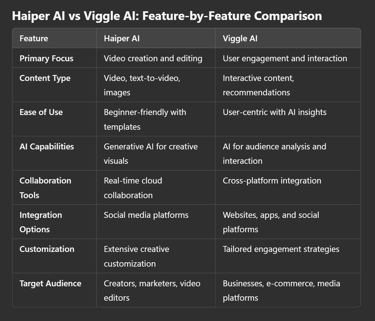
Haiper AI vs Viggle AI: Choosing the Right AI for Your Needs!
Explore the detailed comparison between Haiper AI and Viggle AI. Learn about their features, strengths, limitations, target audiences, and future potential. Discover which AI tool best fits your creative or engagement needs in this in-depth analysis.
AI/FUTUREEDITOR/TOOLSAI ART TOOLSARTIST/CREATIVITY
Sachin K Chaurasiya
12/25/20245 min read


Artificial intelligence (AI) has become an integral part of various industries, with tools catering to specific needs, such as video editing, content creation, and user engagement. Two emerging players in this space, Haiper AI and Viggle AI, have drawn significant attention for their innovative approaches. In this article, we’ll provide an in-depth comparison of Haiper AI and Viggle AI, focusing on their features, capabilities, applications, and overall value to users.
Haiper AI
Haiper AI specializes in creative tools for video editing, text-to-video conversion, and image generation. Designed for content creators, marketers, and video editors, Haiper AI simplifies the process of producing high-quality visual content. By leveraging state-of-the-art generative AI algorithms, Haiper AI caters to professionals and beginners alike who seek efficient solutions for visual storytelling.
Key Features
Text-to-Video Conversion: Users can input text scripts, and Haiper AI generates video sequences with relevant visuals, animations, and transitions.
Advanced Video Editing: Offers precision tools for trimming, layering, and effects, powered by AI-enhanced automation.
Image Generation: Enables the creation of custom images based on user prompts, using generative AI technology.
User-Friendly Interface: Intuitive UI and templates make it accessible for creators with minimal technical expertise.
Collaboration Tools: Cloud-based features allow real-time collaboration among team members on video projects.
Integration with Social Platforms: Direct publishing options for platforms like YouTube, Instagram, and TikTok.
AI-Powered Recommendations: Suggests enhancements and edits based on content type and target audience.
Customizable Templates: Pre-designed templates for specific industries, such as e-commerce, education, and real estate.
Target Audience
Digital marketers
Content creators
Social media managers
Video production teams
Small business owners looking to create professional content
Strengths
Creativity-Driven: Haiper AI is ideal for producing visually stunning content with minimal effort.
Efficiency: Reduces time spent on manual video editing through AI automation.
Scalability: Allows small teams or individuals to compete with larger production houses.
Diverse Outputs: Supports a wide range of video formats suitable for various platforms.
Enhanced Accessibility: Customizable features make it suitable for users with varied technical skills.
Limitations
Limited focus on user engagement metrics compared to Viggle AI.
May not be suitable for businesses primarily seeking interaction-based tools.
It requires a stable internet connection for optimal performance.
Subscription costs may be higher for premium features.
Use Cases
You need to create promotional videos, tutorials, or marketing content.
Your goal is to enhance the quality of visual storytelling.
You require tools for collaborative video editing projects.
You want to automate repetitive editing tasks for faster production.
You aim to improve the creative appeal of social media campaigns.
Viggle AI
Viggle AI is a distinctive platform aimed at enhancing user engagement through interactive and personalized content experiences. Known for its focus on engagement metrics, Viggle AI combines AI-driven insights with tailored content delivery to captivate audiences. While it’s less focused on visual content generation, Viggle AI excels in optimizing and curating content to drive user interaction.
Key Features
Personalized Content Recommendations: Uses AI to analyze user behavior and suggest tailored content.
Gamification and Rewards: Implements gamified elements to encourage user interaction, such as quizzes, polls, and rewards.
Audience Insights: Provides data-driven reports on user preferences, engagement patterns, and content performance.
Cross-Platform Integration: Seamlessly integrates with websites, apps, and social media platforms for unified user engagement.
AI-Driven Interaction: Leverages chatbots and virtual assistants to interact with users and gather feedback in real-time.
Behavioral Analytics: Tracks and predicts user trends for proactive engagement strategies.
Content Optimization Tools: Provides suggestions for improving content performance based on user engagement metrics.
Interactive Campaign Tools: Enables businesses to create engaging campaigns with interactive features, boosting retention.
Target Audience
E-commerce platforms
Media companies
Online learning platforms
Businesses focused on user retention and engagement
Developers creating interactive digital experiences
Strengths
Engagement-Centric: Viggle AI’s primary focus on user engagement makes it a valuable tool for customer retention.
Data-Driven Decisions: Provides actionable insights that help businesses optimize their content strategies.
Gamified Experiences: Keeps users coming back with interactive and rewarding features.
Adaptability: Suitable for diverse industries, from education to retail.
Audience Growth: Increases user retention rates through personalized campaigns.
Limitations
Lack of advanced video or image generation capabilities.
Primarily suited for engagement rather than direct content creation.
Steeper learning curve for those unfamiliar with analytics-driven tools.
Customization may require additional resources or expertise.
Use Cases
Your focus is on increasing user interaction and engagement.
You’re looking for personalized content delivery solutions.
You want to gamify your platform to attract and retain users.
Your business thrives on audience insights and predictive analytics.
You aim to build long-term customer loyalty through tailored strategies.


Pricing & Value
Both platforms offer subscription-based pricing models, but the exact costs vary depending on usage and customization needs. Haiper AI’s pricing typically reflects its advanced creative tools, while Viggle AI’s cost aligns with its engagement optimization features. It’s recommended to explore free trials or demos to assess which platform better suits your requirements. Additionally, enterprise-level users may benefit from custom pricing packages tailored to their scale and scope of operations.
Future Prospects
Haiper AI
With the increasing demand for video content, Haiper AI is well-positioned to expand its features, potentially integrating 3D video creation and AI-driven storytelling enhancements. As the platform evolves, we may see more robust integration with AR and VR technologies for immersive content creation. Additionally, partnerships with global content platforms could widen its reach and user base.
Viggle AI
Viggle AI’s future lies in deepening its analytics capabilities and exploring AI-driven predictive engagement. Integrations with emerging platforms such as metaverse spaces and advanced IoT (Internet of Things) solutions could redefine how businesses engage with users in real-time. Enhanced AI chatbots and voice assistants may also add another layer of interactivity for users.
Let's consider the following sections:
Comparative Case Studies: Provide hypothetical or real-life examples of how businesses or individuals used Haiper AI and Viggle AI successfully to achieve their goals. For instance, a digital marketing agency using Haiper AI for video ads and a streaming platform leveraging Viggle AI to boost viewer retention.
Customer Testimonials and Reviews: Add snippets of feedback from actual users or general sentiments about each platform, emphasizing their strengths in real-world scenarios.
Technological Underpinnings: Dive briefly into the AI technologies that power each platform, such as machine learning models, neural networks, or proprietary algorithms.
Competitor Landscape: Contextualize both platforms by mentioning other competitors in the space and highlighting what makes Haiper AI and Viggle AI unique.
Future Innovations: Speculate on where these platforms might head in the next 5–10 years based on current trends, such as generative AI advancements or new audience engagement methods.
Environmental and Ethical Impact: Discuss the environmental impact of AI (e.g., energy usage for training models) and whether these platforms have initiatives to mitigate such issues. Additionally, touch on ethical considerations, such as data privacy and user consent.
Haiper AI and Viggle AI serve distinct purposes, making them valuable in their respective domains. Haiper AI excels in video editing and visual content generation, catering to creators and marketers looking for efficiency and creativity. On the other hand, Viggle AI focuses on user engagement and retention, making it ideal for businesses aiming to captivate their audiences.
Choosing between Haiper AI and Viggle AI depends on your specific needs. If your priority is producing high-quality videos and images, Haiper AI is the clear choice. However, if enhancing user engagement is your primary goal, Viggle AI is the better option. Both tools, in their own ways, exemplify the power of AI in transforming digital experiences.
Subscribe To Our Newsletter
All © Copyright reserved by Accessible-Learning Hub
| Terms & Conditions
Knowledge is power. Learn with Us. 📚


